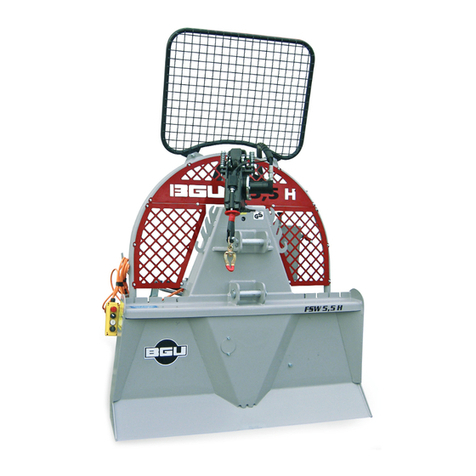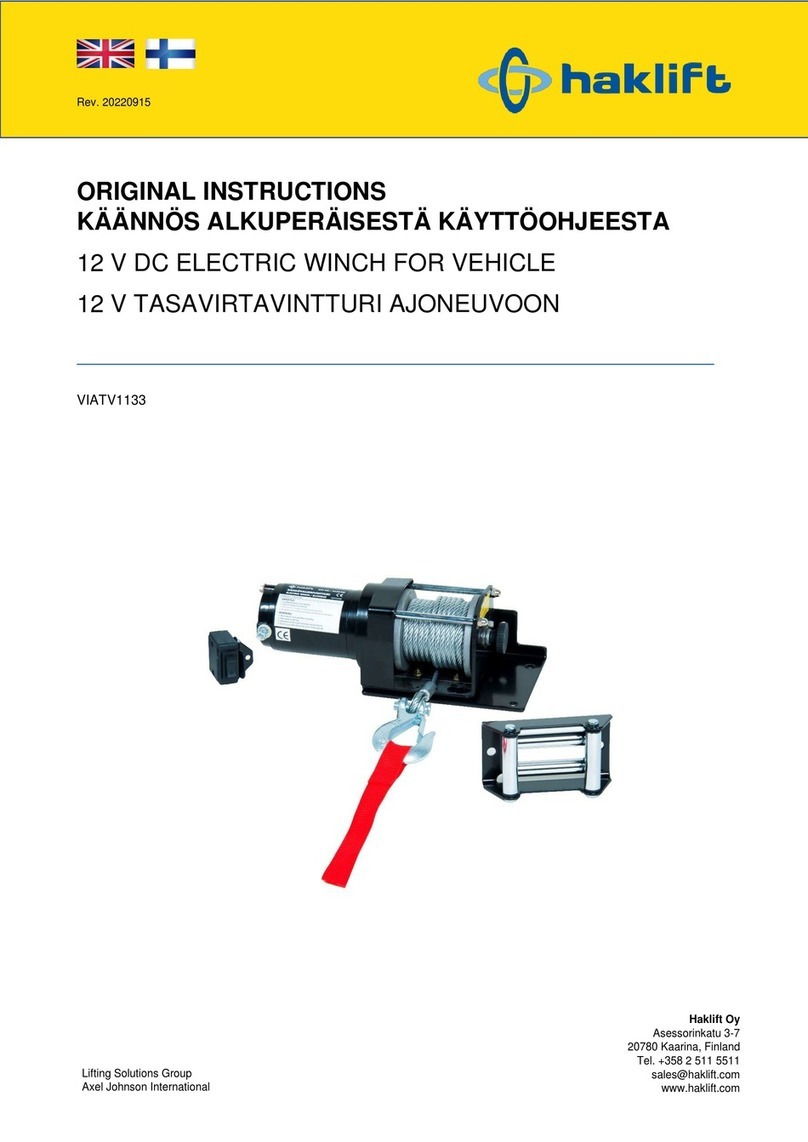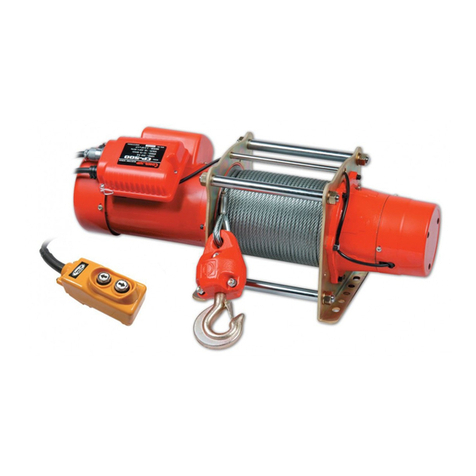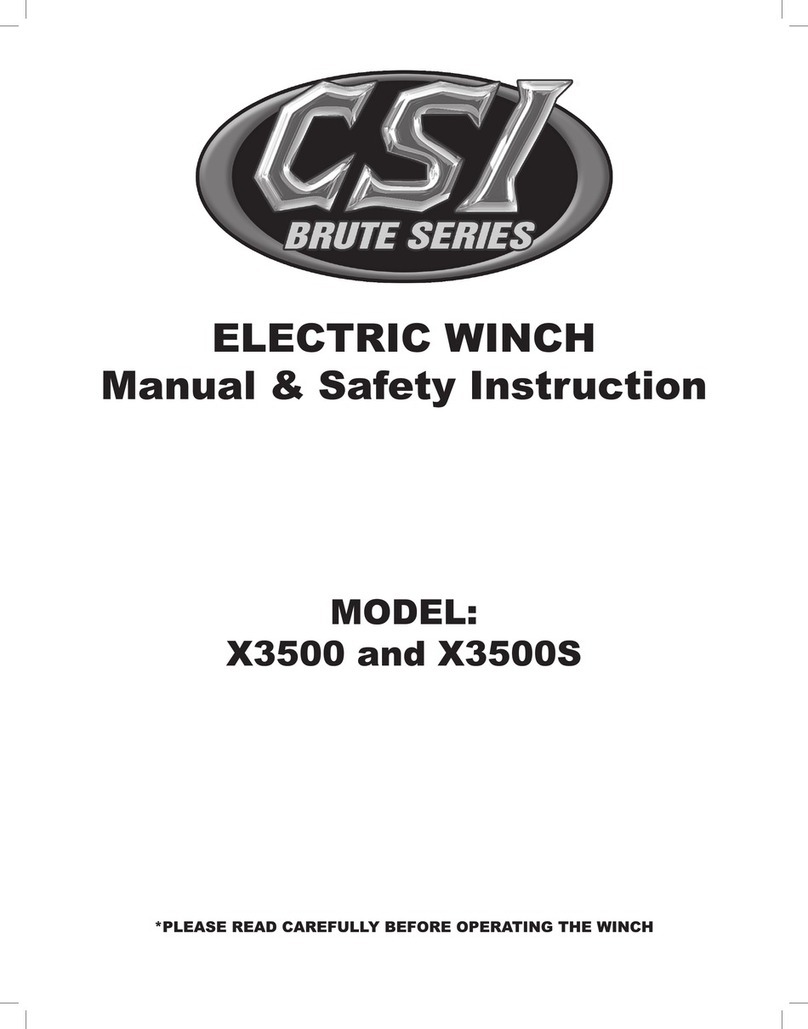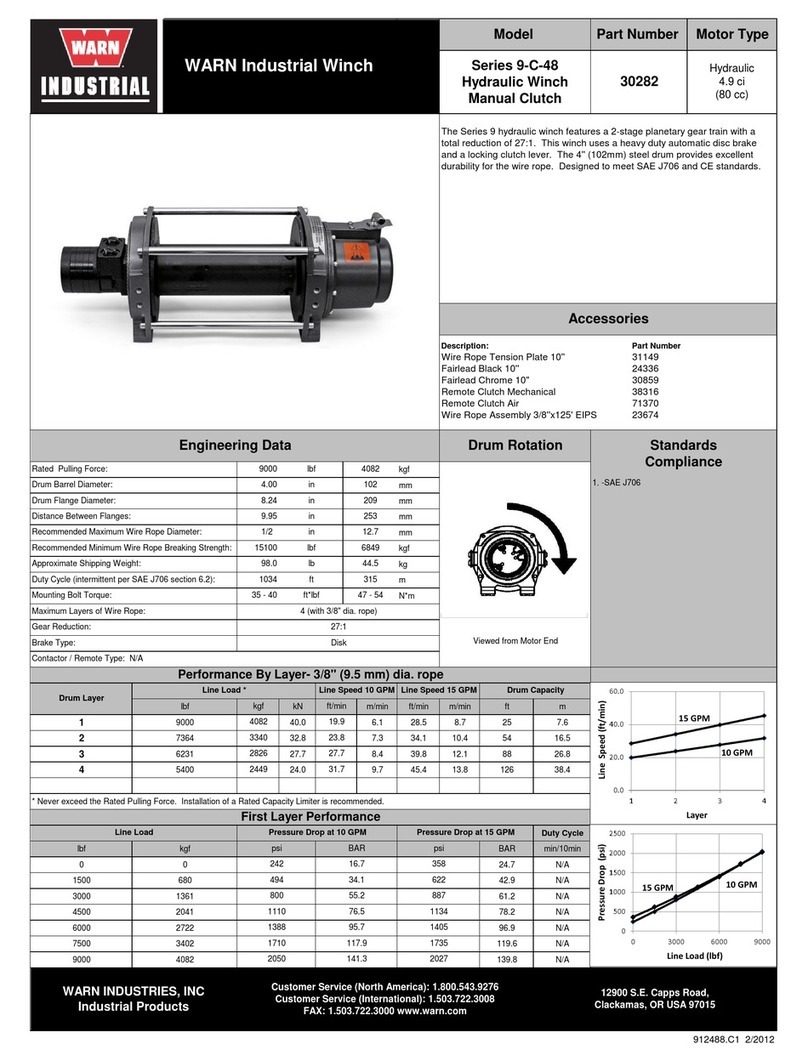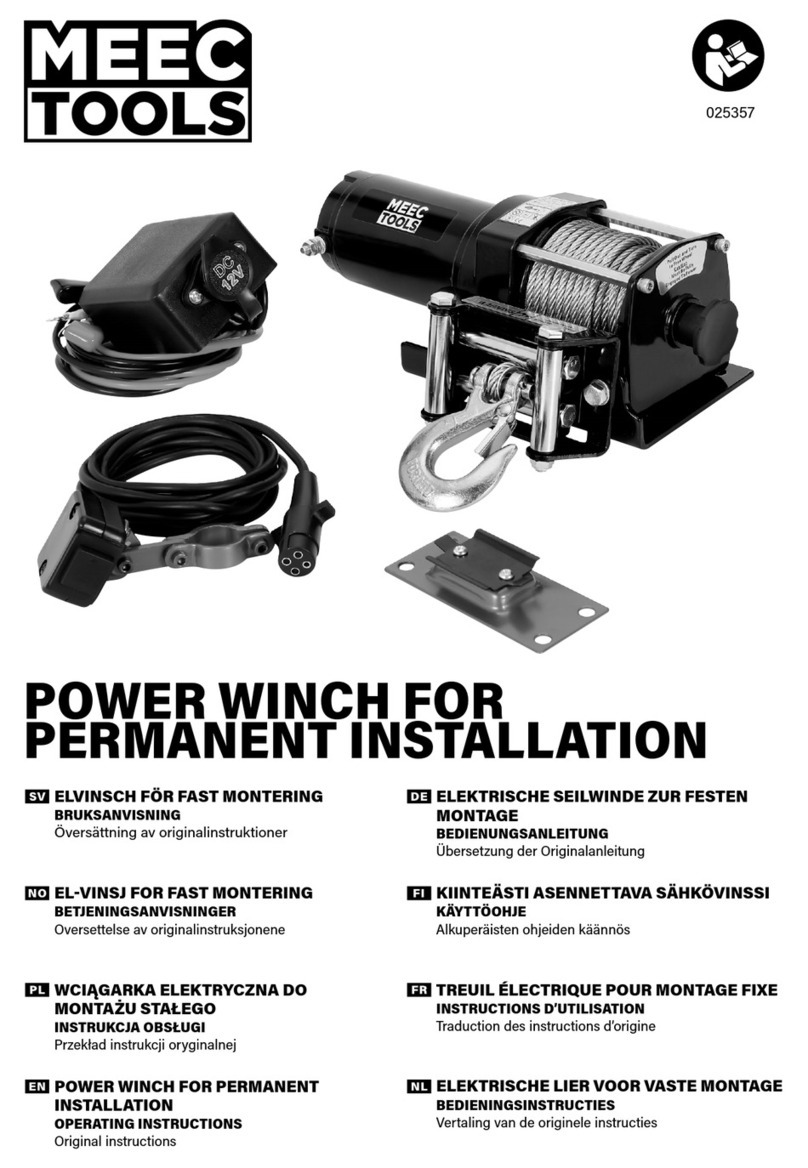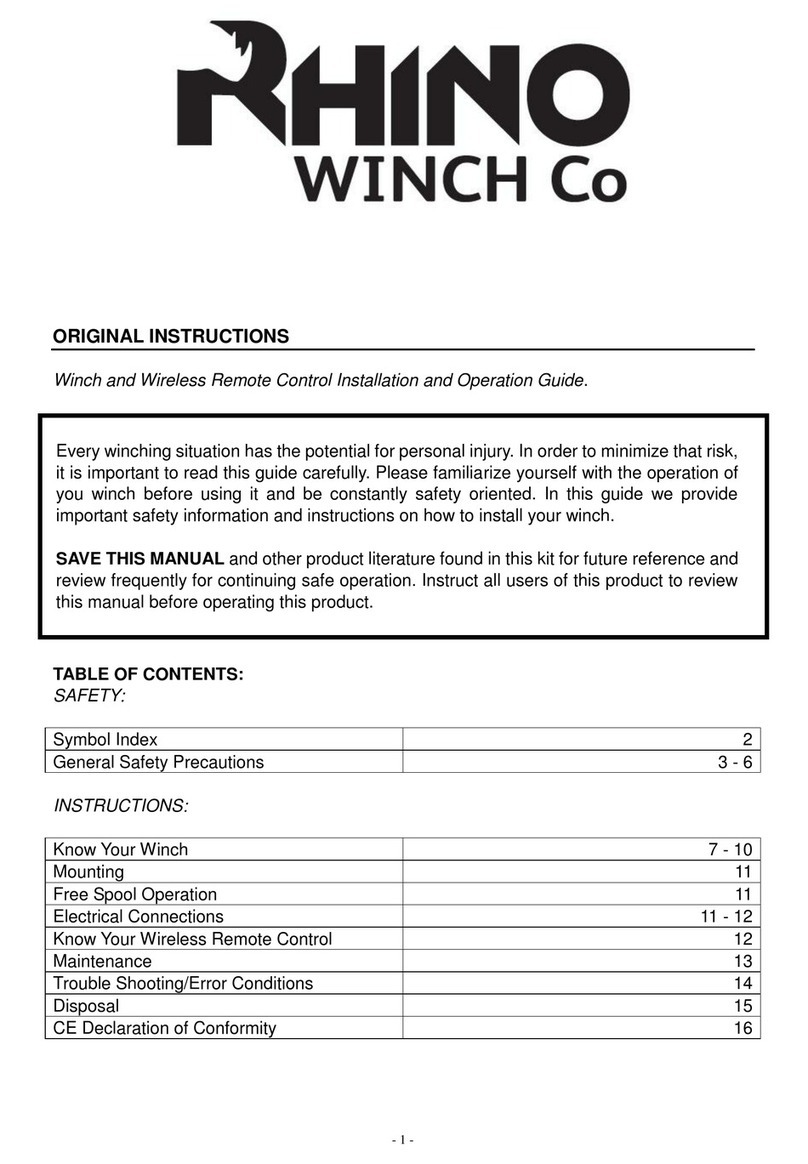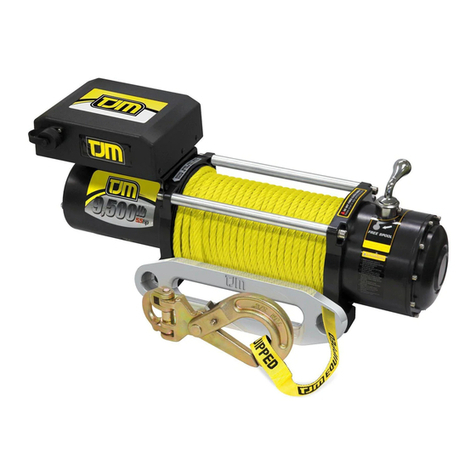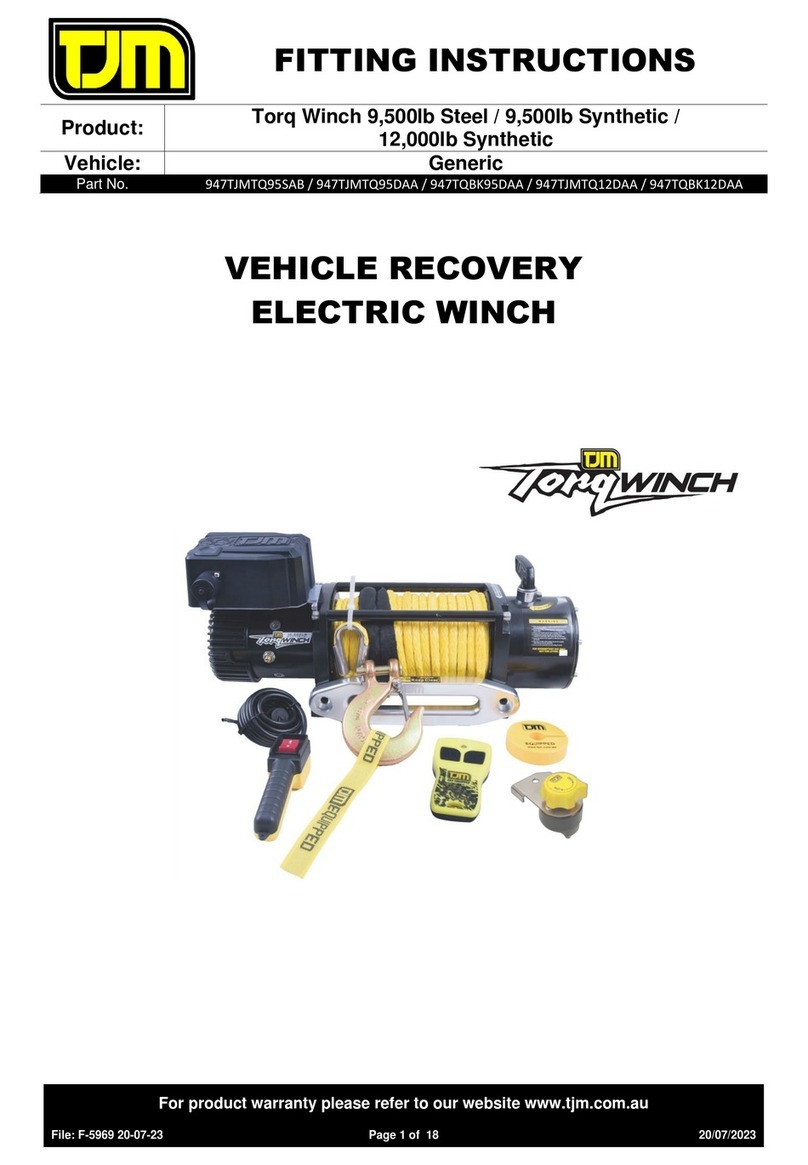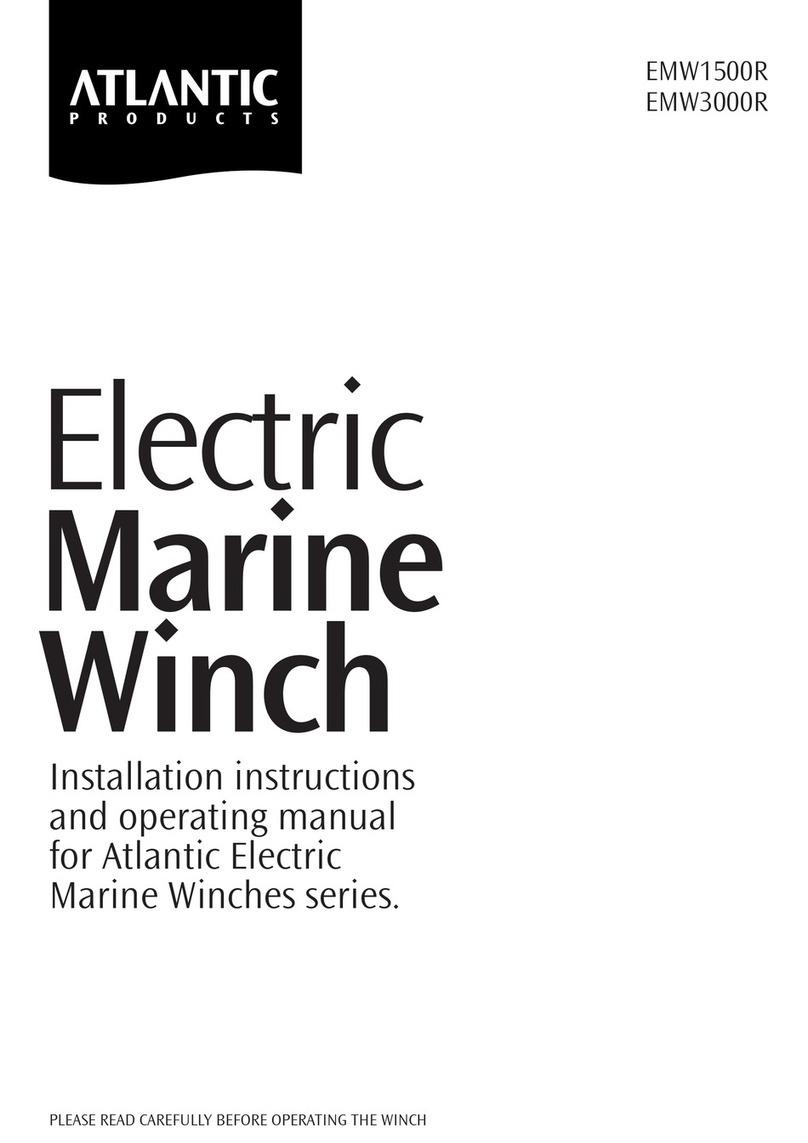BGU FSW 9.5 HV Profi User guide

Original Instruction Manual
Carefully read these instructions before starting and
using your log winch!
Südharzer Maschinenbau GmbH
Helmestraße 94 ∙ 99734 Nordhausen/Harz
Zentrale: 03631/6297-0 ∙ -111
Internet: www.bgu-maschinen.de
e-mail: [email protected]
Set-up & installation
Use
Maintenance
Accessories
Logging Winch
FSW 9.5 HV Profi
hydraulic drive

2
CONTENT
1. General information 3
1.1 About the manual 3
1.2 Delivery and transport claims 3
2. Safety pictograms and warning labels 5
4. Safety 6
4.1 Mandatory application field 7
5. About PTO 9
6. Operating instructions 9
6.1 Minimum tractor requirements 9
6.2. Attaching the winch to the tractor 9
6.3 Positioning the drawbar to the PTO shaft 10
6.4 Wire rope installation 10
6.4.1 Spooling off the wire rope 11
6.4.2 Checking the wire rope quality 11
6.4.3 Spooling of the wire rope 11
6.4.4 Adjusting the line pull 12
6.5 Skidding operations 12
6.5.1 Use of a frontend bucket 12
6.6 Adjustments 13
6.6.1 Clutch mechanism 13
6.6.2 Drum lock 13
6.6.3 Safety brake 13
6.6.4 Stretching the drive chain 14
6.7 Lubrication 14
6.8 Checking the hydraulic oil 15
6.9 Malfunctions 16
7. Repairs and maintenance 17
7.1 Ordinary maintenance 17
7.2 Effects of overload and misuse 18
7.3 About hydraulic oil 19
8. Dismounting and discarding an obsolete winch 20
9. Hydraulic diagram 21
10. Technical specifications 22
11. Wiring diagram 23
12. Other areas of possible hazard 24
12.1 Mechanical dangers 24
12.2 Electric dangers 24
13. Legal warranty 25
14. Extended warranty 25
15. EC Statement of compliance 26
16. Warranty tips for first wire rope use 27

3
Dear customer,
Thank you very much for your trust and preference in choosing our
equipment and joining the number of our best customers in the world.
We are confident that our equipment will be up to all your expectati-
ons and assure you a long lasting quality and performance.
Our timber winches are available in two different versions of different
pull force.
FSW 9.5 pull force 9,5 tons hydraulic operation system
All versions are designed and conceived for farming and logging appli-
cations. Any other use shall be considered non-compliant application.
The manufacturer accepts no responsibility for damages caused by
non-compliant application. In this case the operation of the machine is
completely at user’s risk.
1.1 About the manual
Please take time to read this manual and learn to how operate and
maintain the processor safely. For your easier reading this manual is
laid out in several sections. The sections are progressively numbered
and listed on the “content” page. The information, pictures and tech-
nical data in this document reflect current or planned product features,
functions, and characteristics as of the publication date. Because of
on-going product improvements and feature additions, information in
this document is subject to change without notice. If you are experi-
encing a problem or a functional trouble on your machine, please read
the “trouble-shooting” section to identify possible causes and remedies.
If the problem or functional trouble is not listed in the trouble-shooting
chart contained in this manual, ask your Authorized Service Centre for
service. When you have checked all the possible causes listed and you
are still experiencing the problem, ask your Authorized Service Centre
for help. When you order parts, maintenance or repair services, your
Authorized Service Centre, your dealer or eventually the manufacturer
need your machine serial number and engine serial number. These are
the numbers that you have recorded on the product identification label
of the manufacturer on the machine.
1.2 Delivery and transport claims
Upon delivery of the machine please check for visual machine damages
such as damaged packing or scratched buckled parts. If so, make a re-
mark on all copies of the delivery bill before signing for acceptance. The
truck driver must absolutely sign all copies of the delivery bill. Should
your shipper or the truck driver refuse to accept your claim, fully reject
delivery and make sure to inform us (the manufacturer) immediately.
1. GENERAL INFORMATION

4
Also have the truck driver sign al copies of the delivery bill.
Should your shipper or the truck driver refuse to accept your claim,
fully reject delivery and make sure to inform us (the manufacturer)
immediately. No claims shall be taken into account by the shipper or
by the insurance company, if a reservation note is not made on the
delivery bill.
All transport damages must be notified within latest 2 days from de-
livery. Therefore delivery must be collected and inspected within this
term. Later claims shall be disregarded. In case of assumed but not
visually clear transport damages, make sure to mark the following
sentence on the delivery bill: „Reserved delivery due to assumed
transportation damages.“ Insurance and shipping companies act
with extreme caution in case of transport damages and sometimes
refuse to accept responsibility. Please make sure to provide clear and
exhaustive evidence (photos) of the claimed damages.
Thank you in advance for your help and attention to this matter.

5
2. SAFETY PICTOGRAMS AND WARNING LABELS
1 . Warning label
„Never operate or install a winch without reading or understanding
the operator’s manual!“
2. Danger sign
“Keep yourself and others at safe distance from the dangerous
area!”
This label reminds operators and bystanders of the dangerous
area between the tractor and the winch.
3. Machine safety label
“ max 540 min”
This label shows the max number and the direction of rotation
of the driveshaft connecting the winch to the tractor.
4. Danger sign
„Nur für Bodenzug“
5. Winch operation sign
“Disconnect the winch, read and comply with manufacturer’s
maintenance instructions.”
6. Identification label
„Product identification“
This label shows the company details of the manufacturer and
the main technical data of the machine.
7. Identification label
„BGU-Maschinen” manufacturer’s logo
8. Operator’s safety label
„Wear steel-toe safety shoes”

6
Strictly perform installation, set-up, maintenance, cleaning
and transportation of your winch with the power switched off
and all moving parts motionless against accidental operation.
The user shall strictly comply with these operation, set-up, mainte-
nance, repair and trouble-shooting instructions in order to assure safe
operation and no damages to the equipment. Moreover we recom-
mend to let the machine be run only and strictly by trained and skilled
staff who must be familiar with the applicable occupational safety and
health administration rules as well as applicable transportation rules.
Qualified operators shall be familiar with all risks and harzards rela-
ted to use and operation as well as best practices. Incorrect use of the
saw can cause serious injury or death.
No person under school leaving age should operate a circular saw.
Those who have reached school leaving age but are below the age of
18 may operate a circular saw if supervised by a competent person of
18 years or over. The machine shall be installed and kept in a suitable
location selected by the customer for safest operation.
The machine shall be installed and kept in a suitable location selected
by the customer for safest operation.
The working area around the machine must be kept as clear as pos-
sible from surrounding obstacles and slippery foundation floors should
be duly treated (do not use saw dust or wood ash for this purpose).
Make sure that the equipment stands on a safe stable foundation.
Also make sure to comply with the following provisions:
• Due and proper illumination of the working site must be provided at all times.
• Set up the machine on a firm surface and ensure that a wide but confined
area is available around the machine assuring maximum working freedom.
• Mind all operation sings and warning labels on the winch and comp-
ly with the instruction given herein.
• Operators must wear steel toe safety shoes, working protective
gloves, protective helmet and snug-fitting, tear-resistant work cloths.
• It very dangerous and strictly prohibited to sit/stand on the winch
while transporting it.
• Never leave the forestry winch unattended with the running motor.
• Before switching power on and putting the winch to work make sure
that there are no bystanders in the dangerous area and that you
have good and clear visibility on the work area.
• Provide due and correct mounting of the winch.
• Make sure to comply with driving speed requirements for the specific
road conditions. Use caution when changing direction or turning while
winching uphill, downhill or across slopes.
4. SAFETY

7
• Do not stand in the dangerous area. Assure that nobody stands in-
between winch and tractor, unless the tractor is safely braked and blocks
have been put underneath the wheels to avoid accidental moving.
• Do not remove nor start handling timber before the winch has come
to a complete stop.
• Periodically check that all screws and fixations are tightly in place.
• Before putting the winch to work perform a visual checkup of the
overall conditions and let a skilled technicial overhaul and service
your winch at least once a year.
• It is strictly prohibited to use the winch for any other application
than mentioned in this manual. CAUTION: do not use the winch for
hoisting applications! (Figure 5)
• Make sure that power is fully disconnected from the winch and that
the tractor has been switched off before performing any repair or
work on the winch.
• Never operate the winch without its safeties and protections duly in place.
• Strictly use wire rope of adequate crush resistance, strength and
quality. Provide for immediate wore rope replacement, if any fault
or anomaly is detected.
• Be sure that your wire rope length provides for a free gap to the up
per drum profile of least 1.5 the rope diameter when fully spooled.
In other words, when the rope is fully spooled there should be space
left on the drum for at least two more coils.
• Make sure that your helpers do not put any extra load on the winch
without prior informing the tractor driver.
• Strictly operate the winch from a safe place, at safety distance from the
load, the rope and such other dangers as unfelled trees. The driver seat
accounts as a safe place only if a safety screen is provided to separate the
winch from the tractor in such a way that it may not be removed or by
passed.
Ensure compliance and familiarity with all applicable occupational safety
and health administration rules as well as applicable transportation rules.
Site must be free of slippery surfaces and tripping obstacles. Make
sure that all access ways are properly maintained so that logs can be
safely delivered, loaded and shipped.
4.1 Mandatory application field
Any other use or skidding method than described herein is considered
by the manufacturer as “misuse”. In case of misuse the manufacturer
will not be liable for any injuries or damages and the operator will be
held entirely responsible.
Please make sure to comply with these set-up, operation and mainte-
nance/repair instructions in order to avoid happening of any injury or
dangerous condition.

8
• CAUTION: it is very dangerous to stand in front of a tree to be felled and winched away. (Figure 1)
Fig. 1 Fig. 2
• Winching with a pulley originates a three-sides dangerous area where none is allowed to stand
during winching operations. (Figure 2)
• Never exceed the max admissible pull angle of 30° (Figure 3).
• CAUTION: tip-over risk (Figure 4) when winching on rough terrain or exceeding the maximum
admissible pull angle.
Fig. 3 Fig. 4 Fig. 5
Keep away from the dangerous area!
• You and your helper must establish clear and precise hand signals and review them so everyone
clearly understands.
Pull Stop Release rope
• If your winch is equipped with lower snatch block, use it also for pulling operations.
• The operator should monitor the load throughout the entire pulling operation. Although winches are one-
man equipment, you should never work alone and a second person should be always ready to help.
• Attach your winch to any tractor equipped with road transport tires to avoid infringement of road
travel profi les. If this is not available, provide your towing vehicle with protection chains. Chains are
mandatory on all types of tire for travel on icy or snowy foundations.
• Before disconnecting the winch from the tractor, park on a safe and fl at surface. Drive the winch
down on the special stabiliser foot and hang the driveshaft on the special mount provided on board
of the winch.
• Pinched-hands and injuries danger in the three-point hitching area!
Read this basic guide carefully, familiarize yourself with the operation of your
winch before having to maintain it and be constantly safety oriented.
M
M
a
a
M
a
M
x
x
3
3
0
0
°
M
M
M
M
a
a
x
x
3
3
0
0
°
Pull Stop Release rope

9
5. ABOUT PTO
Use only and strictly CE approved drivelines duly connected and secured in compliance with
manufacturer’s instructions!
• Never use a PTO driveline without safety shield or with a damaged guard.
• Make sure that the shield is of the correct size and length for the drive shaft and is duly mounted on it.
• Use safety chains to secure the shield agaist dangerous rotation and distortion.
• Before operating the PTO driveshaft make sure the rpm number and direction comply with the one
shown by the arrow-sign on the winch. Take all due measures to avoid unauthorized thirds standing the
the dangerous area of the winch!!
Never run the PTO shaft when the tractor motor is switched off!
After dismouting the PTO shaft use the special holder on the winch
to safely store it away.
6. OPERATING INSTRUCTIONS
This timber winch is designed for logging applications only. The winch comprises a welded frame, a
main shaft, a chain wheel clutch, a drum with wire rope, a brake and a snatch-block.
The wire rope is slipped around the timber, the timber is pulled to the skid and the rope is hung up
to the special grooves in the skid by means of fixation chains. Timber and long tree trunks are so
winched to a parking area for loading on trucks and further delivery
6.1 Minimum tractor requirements
Do not PTO operate winch at any faster speeds than max. 540 RPM.
To mount your winch to the tractor use three-point hitch CAT I and Cat II only.
6.2. Attaching the winch to the tractor
Make sure that nobody stand in the dangerous area while connecting the winch
to your tractor
Logging winches can be mounted on any tractor equipped with 3-point hitch of category I or II.
With a special arrangement it is also possible to mount the winch to a tractor with automatic hitch
mechanism on the lower hitch points.
Make sure to strictly use approved IID types and that proper shielding with chain fixation is available.
Make sure to perform accurate connection of your PTO driveline both on winch and power input side.

10
6.3 Positioning the drawbar to the PTO shaft
The length and height of a tractor drawbar may need to be adjusted to match the implement to the
manufacturer’s specifi cations. It is important to make these adjustments to ensure that the PTO
driveline does not compress or separate during operation.
To make this adjustment:
• Mount the winch to the tractor!
• Pull the two halves of your shaft apart and respectively mount them to the tractor and to the winch
and perform a crosscheck as shown below (Fig. 6)
• For increased safety make sure that a minimum wrapping of 200mm (b) occurs when pulling the
hitch bar all the way up and down. With the shaft parallel to the ground also make sure that the shaft
doesn’t hit the stand (wrapping (a) should be still at least 20mm).
• For shortening of the PTO shaft, fi rst cut the telescope off and then the external one by the same length.
• Grind both shaft ends, clear chips and dust away and oil all slinding contact areas before fi nal
assembly.
Fig.6
6.4 Wire rope installation
DO DON‘T
Remove the small protection grid and then take the cap off. Now turn the drum to the right position
for releasing and removing the drum screw. Insert the wire rope through the inlet fairlead and feed it
to the drum by means of the upper block.
(Fig. 9, Pos. 8).
In order to transfer torque from the tractor to the winch you must use a driveline with torque
overload clutch coupler. Mount the winch to the tractor and then secure the stabilisers underne-
ath the lower hitch points. Finally incline the winch by approximately 20° using the upper hitch
bar.
b
a

11
Fit the rope into the special groove and tighten the screw (Pos. 9). Now start spooling as described
under skidding operations.
In order to avoid possible rope damages keep winding up for a while after complete spooling of the
entire rope length, as described under section “Spooling of the wire rope”. Follow exactly these instruc-
tions in order to avoid troubles and assure smooth working with your winch.
6.4.1 Spooling off the wire rope
After you have correctly installed the winch, you can start spooling the rope off. In order to ensure
compliance of your power voltage to the requirements, first switch the tractor rear lights on.
• Press the white push-button (2) Fig. 7 to undo the safety brake.
• Press the black push-button (1) Fig. 7 to engage the brake and allow the rope to spool off. If no
spooling off occurs at this stage, you are probably missing suffient operating pressure in your system.
Remember that your driveline must be engaged for the hydraulic pump to actively power the spooling
system.
• Press the white push-button again and pull the wire rope. If the wire rope is tangled or badly woun-
ded on the drum, first undo 3-4 rope winds and then wind tightly and evenly back onto the drum to
the desired length.
• Should timber hook up on an obstacle (tree trunks, branches or roots) down the skidding route and
skidding be discontinued due to insufficient pullforce to bypass the obstacle, a large pressure will build
up into the rope leading to a risk of backlash during spooling off. In this case, you need to operate the
white push-button (1) by quickly tipping on it several times.
6.4.2 Checking the rope quality
• Stricly use brand new ropes.
• Make sure to use ropes of approved quality, suitable strength and compliant to the specifications on
the identification label.
• Do not use longer ropes than instructed in the technical specifications of this manual.
6.4.3 Spooling the wire rope
Completely spool the rope making sure to wind tightly and evenly onto the drum and avoiding both
over-winding and underwinding. Correct winding is accomplished by:
• Simply pulling the load
• Firmly attach one end of the rope to a firm stable anchor-point suitable to withstand the pull force
while the rope starts spooling onto the drum and the tractor with the winch starts pulling towards the
anchored rope end.
It may be convenient to carry out this operation either on a slight gradient with the idled tractor fa-
cing uphill or alternatively with braked tractor.
Wind the rope tightly and evenly onto the drum. Before putting your winch to
work, spool the rope nearly completely off (just leave 3-4 winds on the drum)
and then respool it again under load on the free end! Check the rope over for
any signs of damage, flattening, broken wires, wear and corrosion.

12
6.4.4 Adjusting the line pull (amount of force the winch needs to produce to move a load)
Adjust the line pull of the winch so that the drum stops rotating at once when no more skidding
occurs. This will reduce chances of “binding”, which is wire rope working it’s way down into a loosely
wound wire rope layer, and catching or damaging itself. To adjust the pullout force:
• Release the locknut
• Release or tighten the adjustment screw used to adjust the flat spring of the brake band
• The line pull is increased or decreased by respectively tightening or releasing the screw
• Tighten the locknut back in place
6.5 Skidding operations
Set the hydraulic cylinder of the tractor three-point hitch in its lowest position. Firmly settle the winch
down on the ground and engage the tractor manual brake. NEVER start pulling operations before
having securely and firmly settled the winch in a stable position.
Press the black push-button on the control panel. The wire rope will now start to wind up onto the
drum. To stop winding simply release the pressure the black push-button. When doing so, the brake
immediately stops the drum and keeps the load away.
For safety reasons, spooling of the rope occurs strictly and only if a consistent pressure is maintained
on the black push-button.
Do not raise the hydraulic cylinder of the tractor three-point hitch during
skidding! (DANGER: you may damage your driveline)
The rated pull force is the largest force produced as the rope starts winding up onto the drum. This is
also the figure that is shown in the technical data reported on the product identification label on the
winch. The pull force of the winch decreases as the rope keeps winding further more onto the drum.
At fully wounded rope the pull force of the winch amounts 50-60% of the rated force.
6.5.1 Use of a frontend bucket
For operation of a frontend bucket a separate hydraulic system is required than the one used to ope-
rate the log winch. One of the double-acting control valves of the tractor is required for bucket opera-
tion.
The bucket is hinged and infinite bucket adjustment is possible from the tractor.
When you take the winch off the tractor make sure to shut the gate valve of the control line by tur-
ning it 90° off in order to prevent the bucket from dropping down while the winch remains parked.
During skidding operations the gate valve must be set along the axis of the control line .

13
6.6.1 Clutch mechanism
Make sure to switch the tractor drive off before attempting any intervention on the winch!
Proper clutch settings will ensure optimum pull force. The clutch is set by the manufacturer during
fi nal testing of the product before shipment. However possible wear of the lining may require some
extent of adjustment as the time passes. If the winch fails to reach the rated pull force, then it means
that new clutch adjustment is required.
To perform clutch adjustment:
• Loosen the small nut (Pos. 1),
• Slightly tighten the nut (Pos. 2),
• As the system is switched on, the motor and the driveline start turning,
• If the wire rope winds up without you having pressed the black push-button (1), then you probably
tightened the nut (Pos. 7) too much and no more gap is available between the clutch and the drum.
In this case release the nut and keep doing so till the rope no longer moves unless the black push-
button was operated.
6.6.2 Prebrake regulation
To facilitate winding of the wire rope, perform prebrake regulation with the screw (10) and the re-
spective wingnut (11) (Fig. 8). A certain extent of prebraking is also performed by the roller fairlead
(Pos. 12, Fig. 8). Exact prebrake regulation will also prevent the rope from unwinding excessively fast
or accidentally slipping off the drum. Extreme fast unwinding and abrupt brake disengagement may
cause severe damages to the wire rope.
Exact prebrake regulation occurs when the rope can be effortless spooled off the drum.
The prebrake arrangement must be disengaged for uphill winching operations in order to ensure ea-
sier pulling of the rope.
6.6.3 Safety brake
As pulling out is over and the brake is ready for use, the safety brake will automatically take up the
load (the drum must not unwind and the rope must be held straight and well stretched). The brake is
set by the manufacturer during fi nal testing of the product before shipment. However, possible wear of
the lining may require some extent of adjustment as the time passes. If the safety brake fails to hold
the load uniformly , then it means that new adjustment is required.
To adjust the safety brake:
• Tighten the nut (Pos. 3, Fig. 8 ) used to tension the spring
• Adjust the nut (Pos. 3 and 4), so that the distance measured between the two nuts (Pos. 1 and 3)
on the threaded spindle is 7 mm
• Finally tighten the nut Pos. 4 to assure perfect adjustment
3 Brakes permanently released
2 Brakes shortly released
1 Skidding
Fig. 7
6.6 Settings

14
Fig. 8 Fig. 9
4
10
11
13
12
6. 7
8
9
15
3
14
1
2
4
5
6
5
3
8
9
10
11
7
2
1
6.6.4 Stretching of the drive chains
After the first operation hours you may possibly experience some extent of release of the drive chain
that will then need to be restretched. Under normal continuing operating conditions the drive chain
should be stretched every 60 operating hours. To perform stretching of the drive chain (fig. 8):
• Remove the safety guard (Pos.1), unscrew the fixation screw (Pos. 2 ) and finally loosen the 4 ad-
justment screws (Pos. 3).
• Loosen the nut (Pos. 6) of the tension screw (Pos. 4) and tighten the tension screw on nut (Pos. 5)
• Keep tightening nut (Pos. 5) until the drive chain (Pos. 7) is duly stretched
• Under a hand pressure, the duly stretched chain must be still capable of minimally moving
• Turn the PTO driveline (Pos. 8) and make sure that this is effortlessly done
• Check the pump drive chain (Pos. 9) and perform new stretching if required. To do so, release the
screw (10) and tighten with nut (11) making sure to avoid excessive tensioning of the chain
6.7 Lubrication
Make sure that the motor is switched off, pull out the tractor keys and wait for
all moving parts to be secured before performing any maintenance/repair work
on the machine.
4 lubrication nipples are available on the winch to respectively perform lubrication of both the upper
and lower snatchblocks and of the rope fairlead. Perform lubrication of the nipple (13) of the pre-bra-
king arrangement (12, Fig. 8).
Make sure to perform lubrication every 15 - 20 operation hours.
CAUTION: improper lubrication may cause dangerous contamination of the sliding parts. In
this case the manufacturer will not be liable for any resulting damage or injury!
3
Lubricate the driving chain after every 40 operation hours.
To lubricate the driving chain use grease suitable for high temperature (it should not melt as common low-price lithium
grease) in order to prevent grease contamination of the sliding clutch surfaces. Strictly use special spray lubricant for link
chains. Provide regular maintenance of the drive chain by removing any eventual residual dirt before greasing it.
BE AWARE: Do not grease the clutch lining because this may lead to a
significant reduction of the line pull and in this case you may be forced
to replace the clutch plates!
All other bearings are self-lubricating ones that require no further lubrication or maintenance.
Provide PTO shaft lubrication in accordance with the instructions of the manufacturer (Fig. 10).
6.8 Checking the hydraulic oil
Perform periodical oil temp checks during operation. Should the
oil temp exceed 70°C, stop the motor, search for the possible cau-
ses and fix the overheating problem before continuing to work.
BEWARE: longterm overheating may permanently damage your
winch hydraulics.

15
Abb. 10
40 h 8 h 40 h 16 h 40 h 8 h 40 h
Lubricate the driving chain after every 40 operation hours.
To lubricate the driving chain use grease suitable for high temperature (it should not melt as common low-price lithium
grease) in order to prevent grease contamination of the sliding clutch surfaces. Strictly use special spray lubricant for link
chains. Provide regular maintenance of the drive chain by removing any eventual residual dirt before greasing it.
BE AWARE: Do not grease the clutch lining because this may lead to a
significant reduction of the line pull and in this case you may be forced
to replace the clutch plates!
All other bearings are self-lubricating ones that require no further lubrication or maintenance.
Provide PTO shaft lubrication in accordance with the instructions of the manufacturer (Fig. 10).
6.8 Checking the hydraulic oil
Perform periodical oil temp checks during operation. Should the
oil temp exceed 70°C, stop the motor, search for the possible cau-
ses and fix the overheating problem before continuing to work.
BEWARE: longterm overheating may permanently damage your
winch hydraulics.

16
6.9 Troubleshooting
Type of trouble Possible causes Remedies
No winch reaction to activa-
tion of the control buttons
of either the control board
or the radio control.
• Winch drive damage
• No power in the system
• Control valve failure
• Check the winch drives (the driveline
must be connected for the pump to be
powered) and the oil level in the oil tank.
• Check power connections (check the
plugging on the tractor, position lamps ON)
• Check the batteries of the radio control,
Check for oxidation of the contacts and
clean them if required
• In case of a power failure, fix the pro-
blem and provide power
• Should the control valve repeatedly fail
to operate, concurrently press the keys of
the control panel and the magnetic pres-
sure peg (located centrally to the front
part of the magnets) to release it.
Line pull is insufficient • Excessive rope on the drum
• Oiled clutch disks due to faulty
lubrication of the drive chain
• Worn-out clutch lining
• Winch drive is damaged
• Oil pressure is too low
• Clean or replace the clutch lining
• Replace the clutch disk
• Replace the damaged parts
Less than 145 bar oil pres-
sure
• Not enough oil in the tank • Check the oil quantity and touch up if
requried. Seal eventual leaking spots.
Insufficient oil pressure • Damaged pump
• Faulty setting of the pressure
switch or of the safety valve
• Ask for customer service
• Ask for customer service
Sudden pressure drop while
the winch is not in use
• Damaged check-valve, relief
valve, control valve or
pressure accumulator
• Ask for customer service
Braking effect is insuffie-
cient
• Wrong brake adjustment
• Grease on the brake band lining
• Damaged brake mechanism
• Worn-out brake band
• Adjust the brake force
• Clean the brake lining and surface
• Replace all damaged parts
• Replace the worn-out band

17
Type of trouble Possible causes Remedies
Rope hard to spool off • Wrong setting of the rope pull-
out force
• Damaged rope
• Damaged brake band
• Adjust the rope pullout force
• Replace the rope
• Replace the brake band
The winch keeps skidding
although the clutch was
deactivated
• Wrong setting of clutch cylinder hub
• Damaged drum
• Damaged clutch disk
• Drive chains excessively stretched
• Adjust the hub of the clutch cylinder
• Replace the drum
• Replace the clutch
7. REPAIRS AND
MAINTENANCE
Make sure that the machine is fully disconnected and all mo-
ving parts are secured before performing any maintenance/re-
pair work on the machine. In the event of any malfunctioning,
switch the machine off before trouble-shooting.
7.1 Ordinary maintenance
Make maintenance a regular part of daily operation. The daily mainte-
nance routine needs to include:
• Check for tightness of all screws and nuts.
• Check for visual mechanical damages of the winch.
• Make sure all safety pins are safely in place.
• Check for PTO shaft correct installation and connection and make
sure that safety shield and chains are duly in place.
• Check the lower hitch points of the tractor and make sure they are
firmly secured (no cross, horizontal movements).
• Check for proper settings of the clutch, brake and rope pullout force.
• Make sure to fix all problems and anomalies before operating your
winch.
Perform the following maintenance works, when required or at regular
time intervals:
• Check-up of the hydraulic oil level (if an oil leakage is suspected, in-
spect the entire hydraulic system, hoses and couplings).
• Lubricate all moving parts when required.

18
Functional controls When to do it How to do it
• Spool the rope off leaving 3-4
winds on the drum and pull out with
load attached to the winch.
• Check rope anchorage and fixation
• On all new winches
• Always as the rope is loose
visual control
• Check the chain tension
• Replace the clutch disks
every 48 operation hours if required or af-
ter 3000 operation hours
through customer ser-
vice
• Replace the brake band Every time when adjsting the brake force
is no longer possible and latest after 3000
operation hours
through customer ser-
vice
• Lubricate the drive chain Every 48 operation hours Lithium grease
• Lubricate all bearings of the upper
and lower pulleys as well as all mo-
ving parts
at least once a month Lithium grease
• Clean casings inside every 100 operation hours or more
frequently in case of hard working
conditions
Release all screws and
remove cover without
removing the nuts
All log winches are function and safety tested by the ma-
nufacturer before shipment. Please strictly use original spa-
re parts for replacements. Use of non-original spare parts
may lead to functional troubles or damages that will void the
manufacturer’s warranty and liability.
7.2 Effects of overload and misuse
• burnt clutch or brake lining
• damaged brake mechanism
• broken chain
• broken rope reel or damaged reel bearing
• damaged power drive/PTO shaft housing
• damaged power drive, PTO shaft or chain wheels
• strain of winch frame parts
• overstrained, cracked, broken lines, rope or Choker-chain
• deformed drum axle.

19
7.3 Hydraulic oil specifications
Periodically check the oil level inside the hydraulic oil tank. When do-
ing so, accurately avoid contaminating the tank with dirt, wood chips,
sow dust etc... Make sure that the winch never runs without oil or
with a low oil level. When this happens, air is likely to reach inside the
hydraulic loop. Failure to maintain due oil level may cause poor run-
ning and irregular splitter operation (very rough, jerky motions) as
well as major pump damages.
Please schedule your first oil change after approximately 200 operati-
on hours and second one after each 600 operation hours. Thereafter
provide a complete oil change every 1000 operation hours or once a
year.
Recommended oil types:
Mobil DTE 16, Shell Tellus T 46, Castrol Hyspin AVH 46
Perform periodical oil temp checks during operation. Should the oil temp
exceed 70°C, stop the motor, search for the possible causes and fix the
overheating problem before continuing to work. BEWARE: longterm over-
heating may permanently damage your winch hydraulics.
When changing the oil, never let used oil drop down on the ground,
rather collect whole of it in a sealedcontainer for due disposal. Oil dis-
posal containers should be of at least 7 l capacity. If you are using
smaller containers, make sure to drain the tank in more than one
round to avoid spilling old oil out on the ground.
Used oil is very polluting and should be disposed in accordance with
local!

20
8. DISPOSING OF AN OBSOLETE MACHINE
When the winch is fully obsolete and cannot be of any longer use, it
should be duly dismounted ahead of discarding. Certain components
need deactivation and dismantling in order to assure that no further
use is made by other parties and that no worn out parts are recycled
for other applications.
During dismantle be alert for possible recyclable materials and com-
ponents that belong to differentiated waste collection procedures ap-
plicable in your country.
The manufacturer is not liable and undertakes no responsibility for
personal injuries or damages that may result from the recycling of
worn out machine parts and eventual re-use in other applications dif-
ferent than originally stated in this manual.
Dismantling procedure:
Take good note please: each and every dismantling task must beper-
formed by authorized service centres or trained skilled staff only!
● Pull the machine down into single components
● Lock and clamp all moving machine parts
● Deliver each single component only to authorized waste manage
ment facilities
● Drain oil and fuel out of respective tanks and lines before disposal of
the machine
● Remove rubber and plastic parts from the machine that must be se-
parately disposed of.
Deactivated, clamped moving/driving parts and components are of no
further risk and danger.
Electric components must be separately disposed to avoid substantial
environmental threat. In the event of fire on the electric deployment
system of the machine, use of an explosion-proof extinguish system is
required (for example powder fire extinguishers).
Table of contents
Other BGU Winch manuals
Popular Winch manuals by other brands
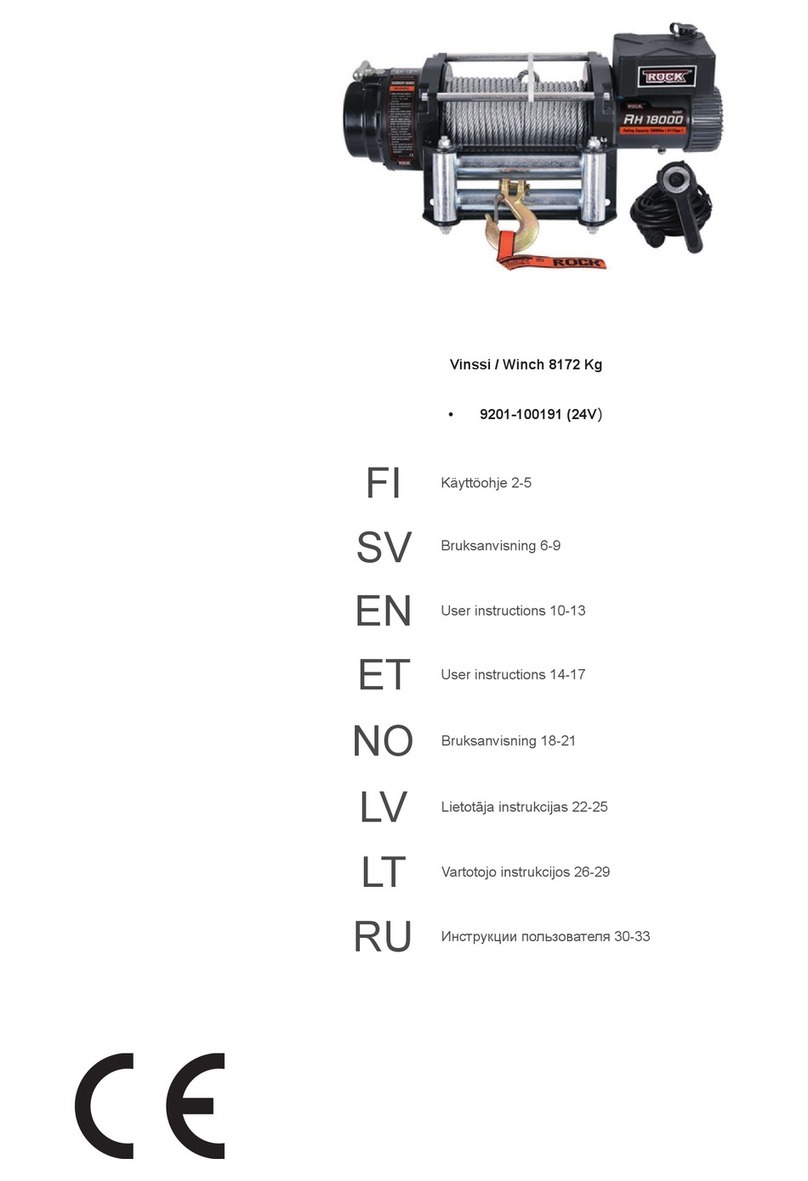
Startax
Startax 9201-100191 User instructions
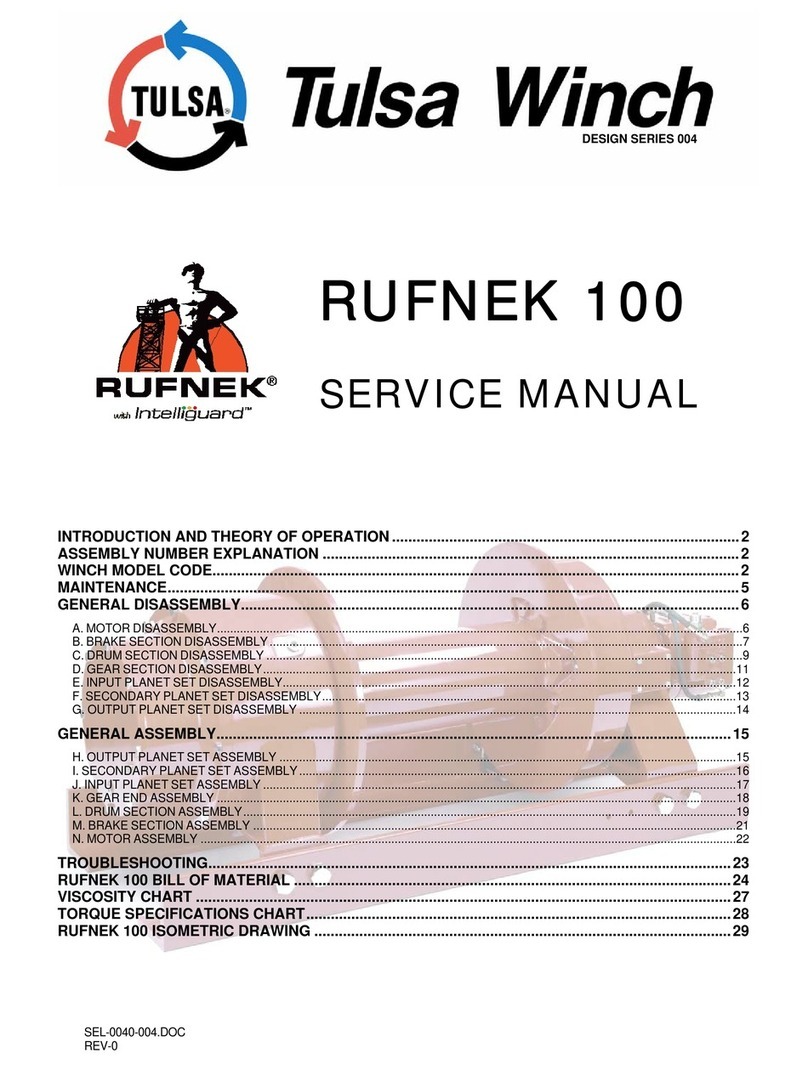
Dover
Dover TWG design 004 Series Service manual
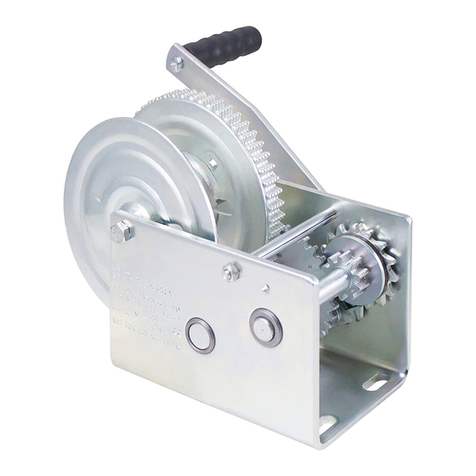
Dutton-Lainson
Dutton-Lainson DLB350A troubleshooting manual
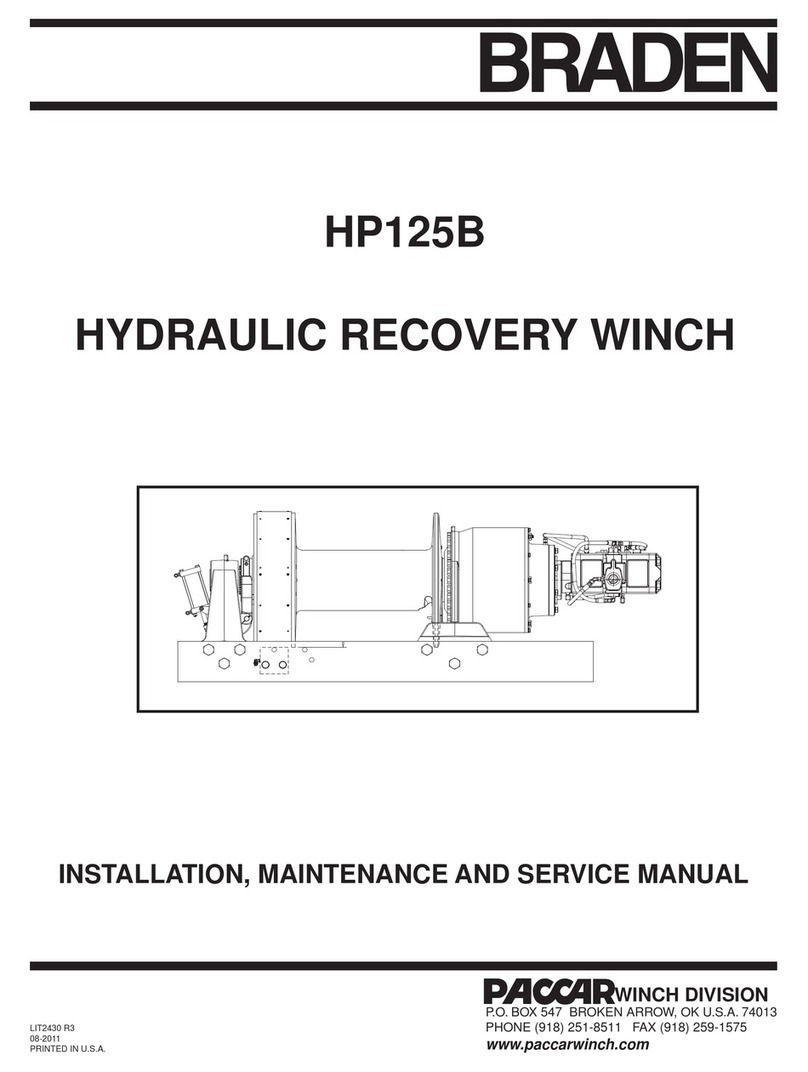
Paccar
Paccar BRADEN HP125B Installation maintenance and service manual
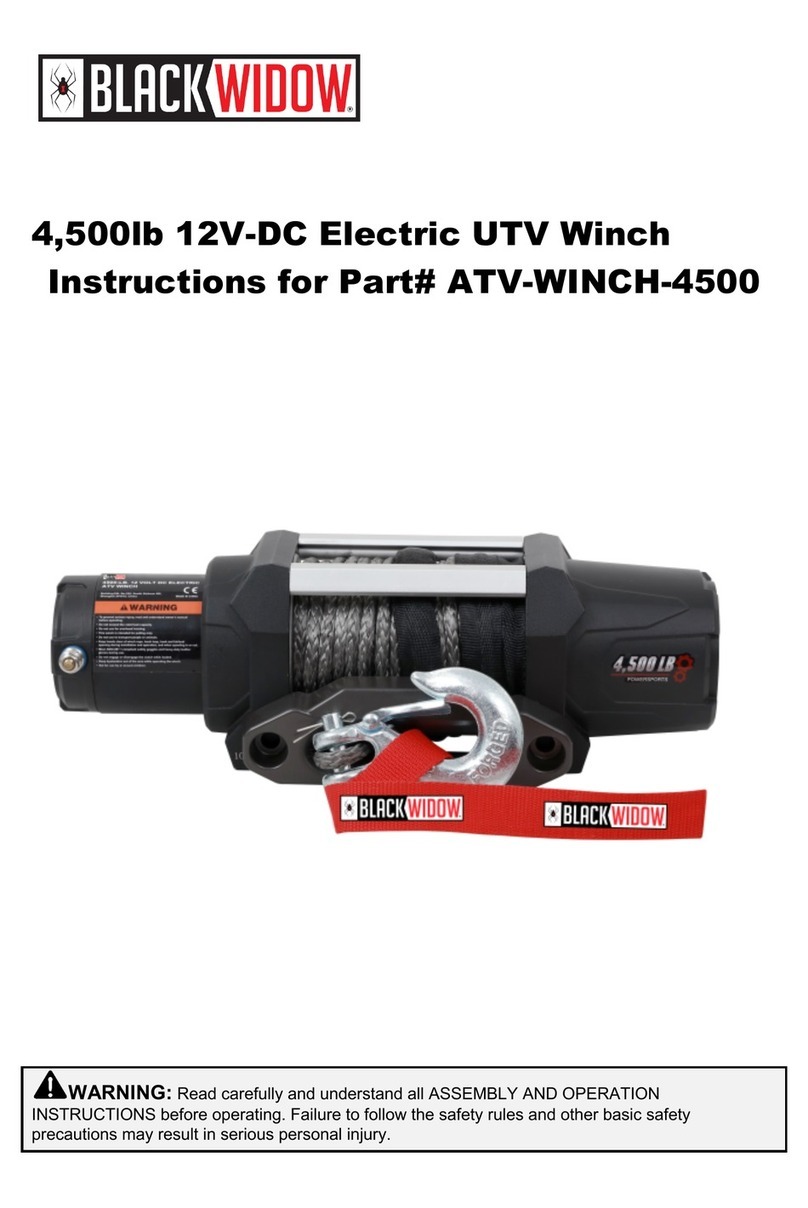
Black Widow
Black Widow ATV-WINCH-4500 instructions
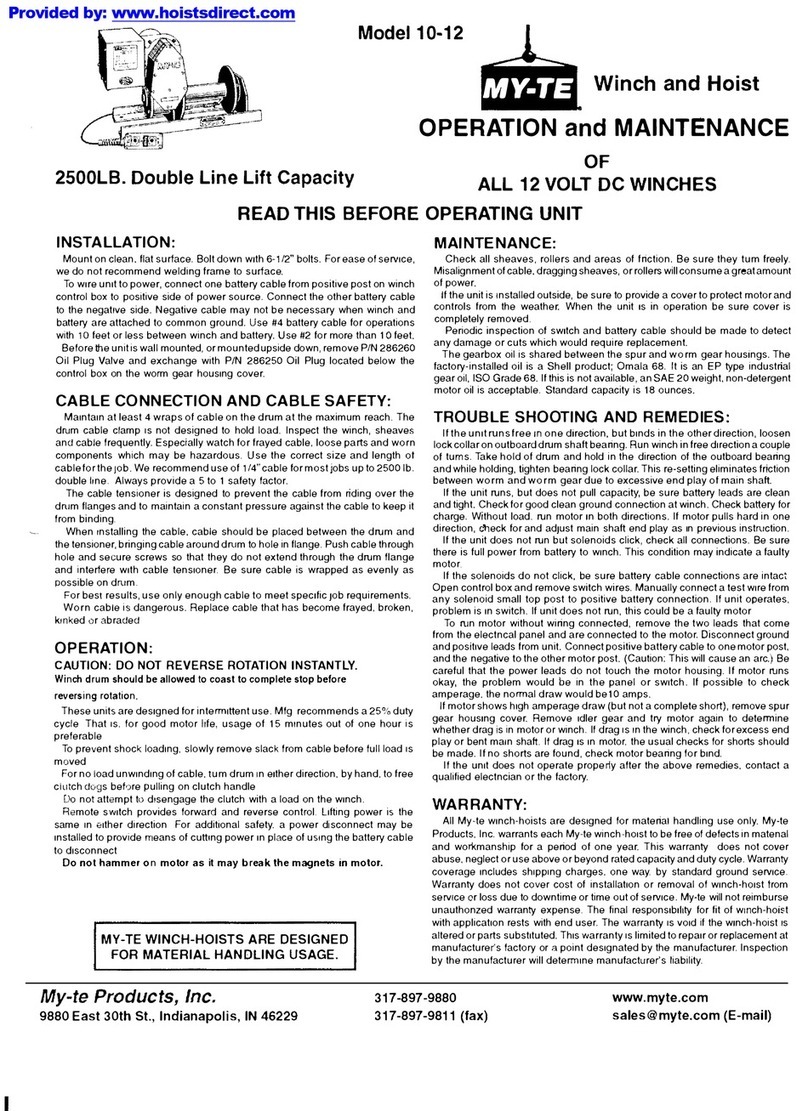
My-te
My-te 10-12 Operation and maintenance
